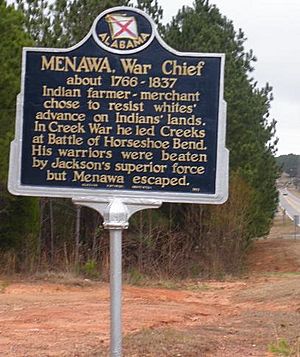Menawa facts for kids
Quick facts for kids
Menawa
|
|
|---|---|
 |
|
| Born |
Hothlepoya (Peter McQueen)
|
| Nationality | Muscogee |
| Occupation | Tribal chief |
Menawa, also known as Hothlepoya (born around 1765, died between 1836 and 1840), was an important Muscogee (Creek) chief and military leader. His mother was Muscogee, and his father was a fur trader with Scottish roots. The Muscogee people followed a matrilineal system. This means a person's family line and status came from their mother's side. So, Menawa's leadership role came from his mother's clan.
He grew up among the Upper Creek people in what is now Alabama. As an adult, he joined the "Red Sticks". This group wanted to keep their traditional ways and avoid adopting European-American customs. Menawa led Red Sticks warriors during the Creek War (1813–1814). He survived the famous Battle of Horseshoe Bend. In 1825, Menawa led about 150 "lawmenders." These were people who enforced tribal laws. They attacked Chief William McIntosh because he had signed a land treaty without the tribe's permission. They killed McIntosh, burned his home, and took his property, including livestock and people he had enslaved.
Menawa's Early Life and Family
Menawa was born in a village called Oakfuskee. This village was located on the Tallapoosa River in what is now Alabama. Today, this area is covered by Lake Martin, which was created by a dam.
His mother was a high-ranking Muscogee woman. His father was a fur trader, mostly of Scottish background. It was common for people from both cultures to form alliances like this, as they believed it helped everyone. Because the Creek people were matrilineal, Menawa was raised within the Creek tribe. He gained his social standing from his mother's family group, or clan. His mother's oldest brother would have been his main teacher. This uncle would have taught him how to be a man and introduced him to men's groups in the tribe.
Menawa's Role as a Leader
When Hothlepoya became the second chief of Oakfuskee, he was given the name Menawa.
In the early 1800s, Menawa became one of the main leaders of the "Red Sticks". These were also known as the Upper Creeks. They worked hard to bring back traditional Creek practices. They also resisted changing their ways to be more like European-Americans. Menawa became a warrior leader in the Creek War (1813–1814). This war started as a civil war among the Creek people themselves. There were big disagreements between the Upper Creek and the Lower Creek. During this time, the British were fighting the United States in the War of 1812. The British supported the Red Sticks. They helped them resist American settlers who were moving onto their lands.
Menawa was the second-in-command of the Red Sticks at the Battle of Horseshoe Bend in 1814. In this battle, General Andrew Jackson led militias from Tennessee, Georgia, and the Mississippi Territory. He also had help from allied Cherokee warriors. The Red Sticks were defeated. Menawa was shot seven times during the battle. But he managed to escape and survived his injuries.
After the war, Menawa kept fighting against European-Americans taking Creek lands. Some Lower Creek chiefs had already given up tribal lands in earlier treaties. In 1825, Chief William McIntosh, a Lower Creek leader, signed the Treaty of Indian Springs (1825) with the United States. This treaty gave away most of the remaining Creek land east of the Mississippi River. Georgia put a lot of pressure on the tribe to sign. However, the Upper Creek, who were the majority, did not agree with giving up land. The Creek National Council had a law that said giving away land was a serious crime. They declared that the people who signed the 1825 treaty were traitors. The Council ordered them to be punished.
On April 30, 1825, Menawa led a group of 120 to 150 "lawmenders." These were people from the towns whose land had been given away. They carried out the punishment on Chief William McIntosh and Etommee Tustunnuggee. These men had given away communal Creek land without the National Council's permission. Menawa's group burned down McIntosh's large house at Indian Springs. They also took his property, including 100 people he had enslaved, his livestock, and his crops. Later that day, they found Samuel and Benjamin Hawkins, who were McIntosh's sons-in-law and had also signed the treaty. They punished Samuel, but Benjamin managed to escape.
In 1826, Menawa was part of the Creek National Council. He traveled to Washington D.C. with other leaders like Opothleyahola and Selocta Chinnabby. They went to protest the Treaty of Indian Springs. The Creek leaders then signed a new agreement with the U.S. government, called the Treaty of Washington (1826). This new treaty canceled the Treaty of Indian Springs. In this new treaty, the Creek still gave some land to Georgia. In return, they received money and a yearly payment. However, the state of Georgia ignored the new treaty. They continued to try and force the Creek people off their lands.
Menawa is believed to have died during the forced removal of the Creek people. This happened in the 1830s, when hundreds of Creek people were moved to Indian Territory. A soldier named Lt. Edward Deas wrote that Menawa was alive on December 21, 1836, in Little Rock, Arkansas. Menawa's name is not on the records after his group reached Fort Gibson in Indian Territory on January 23, 1837. This means he likely died somewhere between Arkansas and Fort Gibson. His burial place is not known. However, Lt. Deas did not mention Menawa dying in his official reports. This suggests Menawa might have made it to what is now Oklahoma and was buried there quietly after 1837.
See also
 In Spanish: Menawa para niños
In Spanish: Menawa para niños


